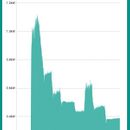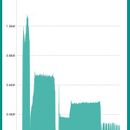Interesting electrical monitoring of my minisplit modulation
I added another transmitter to my whole house Efergy meter to monitor my mini split circuit. Its pretty cool to see how they modulate and run. I also have the return, supply air, and room temperatures being logged as well using an additional acurite weather sensor with temp probe. Some of the data stands out when comparing compressor speeds and outlet temperatures. Was wondering if it would be possible to roughly calculate COP or some other efficiency number with the data I have been logging? Something like it appears at 50 degrees oat at half compressor speed the outlet temp is the same as it running at 10 oat degrees at full capacity.
Monitoring it has really given me invaluable information on what outside temps to run it, fan settings, and the units return temp sensor in relation to room temp.
A couple observations. The fan settings is always forced to run on high at all times so its always at the same speed. I found it runs the best at that setting.
The algorithm in the software always starts the compressor at the lowest speed and slowly ramps it up to full capacity if necessary. There is zero high surge startup load. Any adjustments in compressor speed are done very slowly over the course of a couple minutes.
Under some condition I have seen some impressive return air/supply delta T’s of 75+ degrees with 135-150 supply temps.
Mine doesn’t really appear to short cycle. It simply modulates up and down at it lowest output or will just shut off for a minimum of 10 mins or so before it turns back on. I have never witnessed it turning on or off rapidly. Seems to have some limit on short cycling in the software.
Mine rarely ever spends much time running at 100 capacity. It modulates down quickly and spends most of it time at a lower speed. Its amazing how little power these can use to keep a space warm especially when its mild out.
Here are a couple pictures of energy consumption and duct temperatures. Picture 2 and 3 are the same day. Notice the low modulation showing up on the graphs.
GBA Detail Library
A collection of one thousand construction details organized by climate and house part












Replies
Are the defrost cycles identifiable in your graph?
Does the unit ramp up to 100% for defrost?
Walta
> The fan settings is always forced to run on high at all times so its always at the same speed.
High fan speeds combined with little refrigerant flow will cause terrible latent removal (ie, excessive humidity unless you live where it is very dry).
Deleted
Cool graphs!
"Was wondering if it would be possible to roughly calculate COP or some other efficiency number with the data I have been logging?"
If the fan is always running at max speed, you could guesstimate the thermal power output. Look up the manufacturer's rated (volumetric) air flow rate at max speed, then
thermal power = (air volumetric flow rate) * (air density) * (air specific heat) * (supply temperature - return temperature)
Since you're monitoring power, you could also guesstimate the COP:
COP = (thermal power) / (electrical power)
Be careful to use appropriate units, obviously.
And account for latent removal.
According to my data monitoring the most efficient way to run my unit is to take advantage of the big efficiency increase with the warmer temps during the afternoon. I usually leave it on 24/7 but have a schedule programmed to turn it up a few degrees around 2 pm. I found this significantly decreases the evening run times. I guess the house acts like a giant heat sink with the heat lingering well into the evening. The difference is quite noticeable on my graphs.
Also, those with a mini split should really look into adding an electricity monitor. The efergy I have cost $134 and includes the hub and free online monitoring. You can see exactly how your split is running. I have been able to fine tune mine to run at its maximum efficiency. Without it you really have no clue what its doing. I think many would be surprised on how little electricity these units actually use.
Here is a graph from today showing the unit shutting off in the morning and coming back on mid afternoon. Notice when it comes back on in the afternoon it ramps up briefly but then modulates at a much lower power than when it shut off in the morning. The setpoint is also 3 degrees higher when it comes back on in the afternoon.
But two things are occurring in a warmer heating season afternoon:
a) your load is lower AND
b) the heat pump is more efficient
But optimizing to increase b) is legitimate and interesting. Constant setting probably isn't the best heat pump thermostat strategy (although it may be the most practical).
Regarding estimating capacity and COP, the airflow is critical unknown variable. If this is a ductless unit, then you'll just be guessing. Field-measured airflows of ductless units rarely match up with mfr's specs.
What make and model is the heat pump?
Its a 12k btu Pioneer unit which is actually a rebadged Midea/Carrier. The airflow is always the same as I am running it on high fan only through a Cielo wifi controller.
I have determined I can't run mine in heat mode with the auto setting using the head units return air sensor. The fan needs to be on med or high or it cycles too much.
Just recorded some of my highest duct output temperatures. Here on the CT shoreline we have had pretty crappy spring weather. Very damp, rainy, and in the 40's and 50's. It appears with high outdoor humidity and mild above freezing temps the performance increases noticeably. I also noticed the outdoor condenser coil has been dripping water like crazy. There has been a steady stream of water coming out of the condenser pan drain hole.
Does humidity increase heat output? I assume the water running downing the coils helps possibly extract more heat out of the air?
Yes. Latent heat of condensation is substantial.
It is kind of a tease to post about record high duct temps, without numbers.
Supply air temps are largely affected by the return air temps.
I would still like to see graph of power use thru a few defrost cycles.
Walta
Here is an update on monitoring the unit in cooling mode. You can see the unit only ran briefly at full output around peak sun in the early afternoon.
One thing I noticed is the unit uses significantly less power in cooling mode. Peak power is around 800 watts cooling and 1100 heating. It can also throttle down much lower in cooling mode to around 180-200 watts. Its usually closer to 350-400 in heating mode.
I expect that delta-T (inside to out) is lower when cooling so there is less work for the compressor to do. While I don't advise attempting to measure COP, you are in a good position to test if you can find a control strategy that beats steady temperature (compare on alternating days).
Just installed 4- fh06 splits, that will serve very different parts of the house- 3 are right- sized, one is probably too large, but will be turned off much of the time.
I am considering adding Efergy monitoring. Would i want monitoring of all 4 circuits, or just the sub-panel feeding the minisplits? Also, I'm having a hard time figuring out from the Efergy site which system I should get.
Bill
Unless you want to track your energy usage on a zone-by-zone basis, I'd opt for a single TPM monitor attached to the sub-panel feed.
See: https://efergy.us/efergy-tpm/
Thanks CollieGuy-
From what I can see, if you want the TPM monitor (which you need for mini-splits?) you can only monitor 1 circuit per unit.
I may try it, and move it around to look at the different units.
Hi William,
That's correct. I have three TPM monitors that communicate to their respective desktop monitors and to a single hub that enables on-line monitoring (the hub also allows you to download all of this data via your web browser in as little as one minute increments). I believe the hub supports up to five or possibly six transmitters/circuits, and there's no subscription fee.
There are sub-circuit monitoring kits available, consisting of a transmitter and clamps, but I'm not sure if they're compatible with the TPM protocol which as I understand it is unique to this particular version. It would be best to contact Efergy and explain what you have in mind so that they can advise.
And if you would like on-line monitoring, select: https://efergy.us/efergy-tpm-engage/